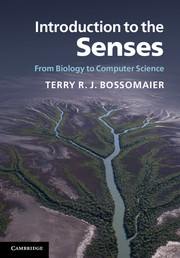Book contents
- Frontmatter
- Contents
- Foreword
- Acknowledgements
- 1 Introduction and overview
- 2 Understanding sensory systems
- 3 Introduction to Fourier theory
- 4 Introduction to information theory
- 5 Hearing
- 6 Basic strategies of vision
- 7 The correspondence problem: stereoscopic vision, binaural hearing and movement
- 8 The properties of surfaces: colour and texture
- 9 The chemical senses
- 10 The somatosensory system
- 11 Non-human sensory systems
- 12 Sensory integration
- References
- Index
- Plate section
10 - The somatosensory system
Published online by Cambridge University Press: 05 July 2012
- Frontmatter
- Contents
- Foreword
- Acknowledgements
- 1 Introduction and overview
- 2 Understanding sensory systems
- 3 Introduction to Fourier theory
- 4 Introduction to information theory
- 5 Hearing
- 6 Basic strategies of vision
- 7 The correspondence problem: stereoscopic vision, binaural hearing and movement
- 8 The properties of surfaces: colour and texture
- 9 The chemical senses
- 10 The somatosensory system
- 11 Non-human sensory systems
- 12 Sensory integration
- References
- Index
- Plate section
Summary
Introduction
This chapter collects together two quite different systems. The first is the sensor system distributed throughout the body which monitors what is going on inside or outside, the temperature, chemical and tactile (pressure and vibration).
The second is the vestibular system which monitors the position and movement of the body in space. It interacts quite strongly with the tactile system. So, for example, the receptors in the skin in the feet contribute to maintaining our balance and can take over if the vestibular system gets damaged. The vestibular system is also tightly coupled to the visual system, through the opto-kinetic control of eye movements and gaze, a topic which §12.1 takes up in detail. Yet it is located inside the ear. Unsurprisingly, these systems share common principles and some transduction mechanisms with the senses considered earlier in the book.
These two systems are at the forefront of developments in virtual reality and computer games. Haptic interfaces are fast growing in importance (§10.8.4) and monitoring gaze has numerous evolving applications in human computer interface design The vestibular system appears obliquely in its role in physically interactive games and total immersion (§12.1.8).
Collectively these sensors comprise the the somatosensory system, from the Greek word soma for body. The sensors embedded in the skin monitor the impact of the external world and gather information about it. Hearing and vision are active senses in that we turn our heads or move our eyes to attend to a stimulus, and we work from hypotheses of what we might be seeing or hearing.
- Type
- Chapter
- Information
- Introduction to the SensesFrom Biology to Computer Science, pp. 246 - 283Publisher: Cambridge University PressPrint publication year: 2012

